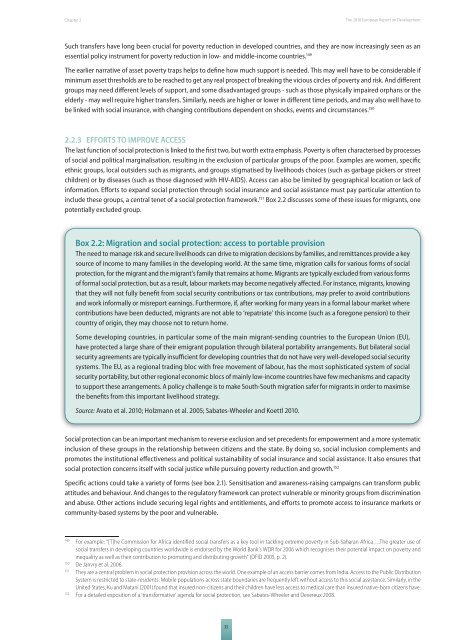social protection for inclusive development - European Report on ...
social protection for inclusive development - European Report on ...
social protection for inclusive development - European Report on ...
You also want an ePaper? Increase the reach of your titles
YUMPU automatically turns print PDFs into web optimized ePapers that Google loves.
Chapter 2<br />
The 2010 <str<strong>on</strong>g>European</str<strong>on</strong>g> <str<strong>on</strong>g>Report</str<strong>on</strong>g> <strong>on</strong> Development<br />
Such transfers have l<strong>on</strong>g been crucial <str<strong>on</strong>g>for</str<strong>on</strong>g> poverty reducti<strong>on</strong> in developed countries, and they are now increasingly seen as an<br />
essential policy instrument <str<strong>on</strong>g>for</str<strong>on</strong>g> poverty reducti<strong>on</strong> in low- and middle-income countries. 149<br />
The earlier narrative of asset poverty traps helps to define how much support is needed. This may well have to be c<strong>on</strong>siderable if<br />
minimum asset thresholds are to be reached to get any real prospect of breaking the vicious circles of poverty and risk. And different<br />
groups may need different levels of support, and some disadvantaged groups - such as those physically impaired orphans or the<br />
elderly - may well require higher transfers. Similarly, needs are higher or lower in different time periods, and may also well have to<br />
be linked with <str<strong>on</strong>g>social</str<strong>on</strong>g> insurance, with changing c<strong>on</strong>tributi<strong>on</strong>s dependent <strong>on</strong> shocks, events and circumstances. 150<br />
2.2.3 EFFORTS TO IMPROVE ACCESS<br />
The last functi<strong>on</strong> of <str<strong>on</strong>g>social</str<strong>on</strong>g> <str<strong>on</strong>g>protecti<strong>on</strong></str<strong>on</strong>g> is linked to the first two, but worth extra emphasis. Poverty is often characterised by processes<br />
of <str<strong>on</strong>g>social</str<strong>on</strong>g> and political marginalisati<strong>on</strong>, resulting in the exclusi<strong>on</strong> of particular groups of the poor. Examples are women, specifi c<br />
ethnic groups, local outsiders such as migrants, and groups stigmatised by livelihoods choices (such as garbage pickers or street<br />
children) or by diseases (such as those diagnosed with HIV-AIDS). Access can also be limited by geographical locati<strong>on</strong> or lack of<br />
in<str<strong>on</strong>g>for</str<strong>on</strong>g>mati<strong>on</strong>. Ef<str<strong>on</strong>g>for</str<strong>on</strong>g>ts to expand <str<strong>on</strong>g>social</str<strong>on</strong>g> <str<strong>on</strong>g>protecti<strong>on</strong></str<strong>on</strong>g> through <str<strong>on</strong>g>social</str<strong>on</strong>g> insurance and <str<strong>on</strong>g>social</str<strong>on</strong>g> assistance must pay particular attenti<strong>on</strong> to<br />
include these groups, a central tenet of a <str<strong>on</strong>g>social</str<strong>on</strong>g> <str<strong>on</strong>g>protecti<strong>on</strong></str<strong>on</strong>g> framework. 151 Box 2.2 discusses some of these issues <str<strong>on</strong>g>for</str<strong>on</strong>g> migrants, <strong>on</strong>e<br />
potentially excluded group.<br />
Box 2.2: Migrati<strong>on</strong> and <str<strong>on</strong>g>social</str<strong>on</strong>g> <str<strong>on</strong>g>protecti<strong>on</strong></str<strong>on</strong>g>: access to portable provisi<strong>on</strong><br />
The need to manage risk and secure livelihoods can drive to migrati<strong>on</strong> decisi<strong>on</strong>s by families, and remittances provide a key<br />
source of income to many families in the developing world. At the same time, migrati<strong>on</strong> calls <str<strong>on</strong>g>for</str<strong>on</strong>g> various <str<strong>on</strong>g>for</str<strong>on</strong>g>ms of <str<strong>on</strong>g>social</str<strong>on</strong>g><br />
<str<strong>on</strong>g>protecti<strong>on</strong></str<strong>on</strong>g>, <str<strong>on</strong>g>for</str<strong>on</strong>g> the migrant and the migrant’s family that remains at home. Migrants are typically excluded from various <str<strong>on</strong>g>for</str<strong>on</strong>g>ms<br />
of <str<strong>on</strong>g>for</str<strong>on</strong>g>mal <str<strong>on</strong>g>social</str<strong>on</strong>g> <str<strong>on</strong>g>protecti<strong>on</strong></str<strong>on</strong>g>, but as a result, labour markets may become negatively affected. For instance, migrants, knowing<br />
that they will not fully benefit from <str<strong>on</strong>g>social</str<strong>on</strong>g> security c<strong>on</strong>tributi<strong>on</strong>s or tax c<strong>on</strong>tributi<strong>on</strong>s, may prefer to avoid c<strong>on</strong>tributi<strong>on</strong>s<br />
and work in<str<strong>on</strong>g>for</str<strong>on</strong>g>mally or misreport earnings. Furthermore, if, after working <str<strong>on</strong>g>for</str<strong>on</strong>g> many years in a <str<strong>on</strong>g>for</str<strong>on</strong>g>mal labour market where<br />
c<strong>on</strong>tributi<strong>on</strong>s have been deducted, migrants are not able to ‘repatriate’ this income (such as a <str<strong>on</strong>g>for</str<strong>on</strong>g>eg<strong>on</strong>e pensi<strong>on</strong>) to their<br />
country of origin, they may choose not to return home.<br />
Some developing countries, in particular some of the main migrant-sending countries to the <str<strong>on</strong>g>European</str<strong>on</strong>g> Uni<strong>on</strong> (EU),<br />
have protected a large share of their emigrant populati<strong>on</strong> through bilateral portability arrangements. But bilateral <str<strong>on</strong>g>social</str<strong>on</strong>g><br />
security agreements are typically insufficient <str<strong>on</strong>g>for</str<strong>on</strong>g> developing countries that do not have very well-developed <str<strong>on</strong>g>social</str<strong>on</strong>g> security<br />
systems. The EU, as a regi<strong>on</strong>al trading bloc with free movement of labour, has the most sophisticated system of <str<strong>on</strong>g>social</str<strong>on</strong>g><br />
security portability, but other regi<strong>on</strong>al ec<strong>on</strong>omic blocs of mainly low-income countries have few mechanisms and capacity<br />
to support these arrangements. A policy challenge is to make South-South migrati<strong>on</strong> safer <str<strong>on</strong>g>for</str<strong>on</strong>g> migrants in order to maximise<br />
the benefits from this important livelihood strategy.<br />
Source: Avato et al. 2010; Holzmann et al. 2005; Sabates-Wheeler and Koettl 2010.<br />
Social <str<strong>on</strong>g>protecti<strong>on</strong></str<strong>on</strong>g> can be an important mechanism to reverse exclusi<strong>on</strong> and set precedents <str<strong>on</strong>g>for</str<strong>on</strong>g> empowerment and a more systematic<br />
inclusi<strong>on</strong> of these groups in the relati<strong>on</strong>ship between citizens and the state. By doing so, <str<strong>on</strong>g>social</str<strong>on</strong>g> inclusi<strong>on</strong> complements and<br />
promotes the instituti<strong>on</strong>al effectiveness and political sustainability of <str<strong>on</strong>g>social</str<strong>on</strong>g> insurance and <str<strong>on</strong>g>social</str<strong>on</strong>g> assistance. It also ensures that<br />
<str<strong>on</strong>g>social</str<strong>on</strong>g> <str<strong>on</strong>g>protecti<strong>on</strong></str<strong>on</strong>g> c<strong>on</strong>cerns itself with <str<strong>on</strong>g>social</str<strong>on</strong>g> justice while pursuing poverty reducti<strong>on</strong> and growth. 152<br />
Specific acti<strong>on</strong>s could take a variety of <str<strong>on</strong>g>for</str<strong>on</strong>g>ms (see box 2.1). Sensitisati<strong>on</strong> and awareness-raising campaigns can trans<str<strong>on</strong>g>for</str<strong>on</strong>g>m public<br />
attitudes and behaviour. And changes to the regulatory framework can protect vulnerable or minority groups from discriminati<strong>on</strong><br />
and abuse. Other acti<strong>on</strong>s include securing legal rights and entitlements, and ef<str<strong>on</strong>g>for</str<strong>on</strong>g>ts to promote access to insurance markets or<br />
community-based systems by the poor and vulnerable.<br />
149<br />
For example: “[T]he Commissi<strong>on</strong> <str<strong>on</strong>g>for</str<strong>on</strong>g> Africa identified <str<strong>on</strong>g>social</str<strong>on</strong>g> transfers as a key tool in tackling extreme poverty in Sub-Saharan Africa….The greater use of<br />
<str<strong>on</strong>g>social</str<strong>on</strong>g> transfers in developing countries worldwide is endorsed by the World Bank’s WDR <str<strong>on</strong>g>for</str<strong>on</strong>g> 2006 which recognises their potential impact <strong>on</strong> poverty and<br />
inequality as well as their c<strong>on</strong>tributi<strong>on</strong> to promoting and distributing growth” (DFID 2005, p. 2).<br />
150<br />
De Janvry et al. 2006.<br />
151<br />
They are a central problem in <str<strong>on</strong>g>social</str<strong>on</strong>g> <str<strong>on</strong>g>protecti<strong>on</strong></str<strong>on</strong>g> provisi<strong>on</strong> across the world. One example of an access barrier comes from India. Access to the Public Distributi<strong>on</strong><br />
System is restricted to state-residents. Mobile populati<strong>on</strong>s across state boundaries are frequently left without access to this <str<strong>on</strong>g>social</str<strong>on</strong>g> assistance. Similarly, in the<br />
United States, Ku and Matani (2001) found that insured n<strong>on</strong>-citizens and their children have less access to medical care than insured native-born citizens have.<br />
152<br />
For a detailed expositi<strong>on</strong> of a ‘trans<str<strong>on</strong>g>for</str<strong>on</strong>g>mative’ agenda <str<strong>on</strong>g>for</str<strong>on</strong>g> <str<strong>on</strong>g>social</str<strong>on</strong>g> <str<strong>on</strong>g>protecti<strong>on</strong></str<strong>on</strong>g>, see Sabates-Wheeler and Devereux 2008.<br />
35
















